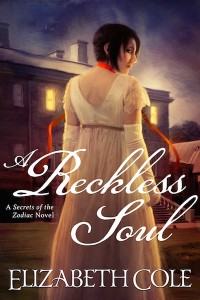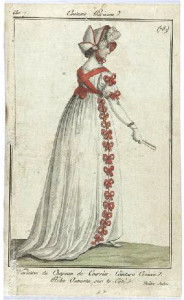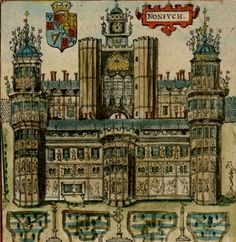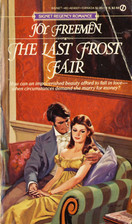
Sometime by the end of the month I’ll send my editor my draft of My Lady Defiant, my next full-length historical romance and a sequel to A Dream Defiant.
The first thing I intend to do after I hit the send button is take a week or two off from writing. I mean to read a lot, finally bake cupcakes with my daughter (I bought her a cake decorating kit and some cupcake books for her birthday in early April, but my weekends have been all about the writing of late), and get back onto Weight Watchers. I know, I know, Weight Watchers AND cupcakes. But I can manage both. Everything in moderation. Except reading. I mean to be very immoderate in that.

Image from Dixie Belle Cupcake Cafe, used under a Creative Commons license
But then comes the momentous decision of what to write next. Oh, part of the answer has to be My Lady Defiant’s sequel. It doesn’t end on a cliffhanger or anything, this being a romance. Yet it does have its share of unanswered questions begging to be addressed, and I mean to answer them in the hero’s younger sister’s story.
However, before I start that sequel, I want to spend my summer trying something different. Very different. My husband recently wrote a blog post about the importance of crop rotation for creative types, and reading it made me realize I need to plant some alfalfa in the form of a fantasy novel, or maybe a contemporary romance. Maybe even that time travel baseball story I came up with while sitting at the ballpark several years back waiting for a Mariners game to start. Or I’ve got that vampire-slaying, garlic-wielding French chef in a Regency-set paranormal, because the fictional world needs more badass chefs. I have lots of ideas–more than I know what to do with, really. Maybe I’ll make a list and let random.org do the picking.
If you’re a writer or other creative type, what do you do for crop rotation?
 Today we welcome guest Elizabeth Cole, author of both historical and contemporary romance. Previously, she worked in bookshops, libraries, and archives…anywhere there were books to be read and cared for. Now she can be found hanging around museums, coffeeshops, and (occasionally) graveyards. In addition to her sweet Regency novellas, Elizabeth is currently writing the SECRETS OF THE ZODIAC, a series of romantic spy thrillers also set in the Regency period. Take it away, Elizabeth!
Today we welcome guest Elizabeth Cole, author of both historical and contemporary romance. Previously, she worked in bookshops, libraries, and archives…anywhere there were books to be read and cared for. Now she can be found hanging around museums, coffeeshops, and (occasionally) graveyards. In addition to her sweet Regency novellas, Elizabeth is currently writing the SECRETS OF THE ZODIAC, a series of romantic spy thrillers also set in the Regency period. Take it away, Elizabeth!
 My newest novel, A Reckless Soul, is set in the Regency, just like the other books in the Secrets of the Zodiac series. Taking place in 1806, it’s the story of two determined spies—one British, one French—who must work together to defeat an enemy who threatens both of them.
My newest novel, A Reckless Soul, is set in the Regency, just like the other books in the Secrets of the Zodiac series. Taking place in 1806, it’s the story of two determined spies—one British, one French—who must work together to defeat an enemy who threatens both of them.
When researching for the story, however, I had to go back a little further. My heroine is French, and she grew up in Paris during the tumultuous period following the French Revolution. It’s a fascinating time filled with not only real history but a lot of legend and propaganda, too. One of the most interesting urban legends was the “Victims’ Ball.” What’s that, you ask?
Maybe you remember this little ghost story: One night in Paris, a young man meets a beautiful woman in a graveyard. She looks sad, wearing a red ribbon around her neck. Of course, the young man falls in love with her instantly (he’s French, after all!). He begins to court her, and every night he falls deeper and deeper in love. There’s just one problem. She never takes off the red ribbon, and soon he’s obsessed with it. So one night, he catches the end of the ribbon, unties it, and OOPS! her head falls right off. Turns out, she was the ghost of a woman beheaded by the guillotine. How tragic! How very French!
I first read that story as a child, in a collection of gruesome tales. But the tale is linked to another urban legend, that of the Victims’ Ball. According to later historians, including Thomas Carlyle in his book, French Revolution, after the Terror ended, the French aristocracy reasserted itself. One of the ways they did was to form morbid dancing societies. To be invited, you had to be “victime” of the guillotine, which meant that you had to be a close relative of someone who had died by the blade. No family martyrdom? No invite. Talk about cliquish!
 Once you had your invitation, you also had to dress properly. There was a very specific look that attendees of the bals des victimes aimed for. Women wore beautiful, filmy dresses trimmed with—you guessed it—red ribbons. Some dresses had the ribbons in a cross-back pattern over the shoulder blades. It was the sartorial equivalent of telling the executioner “x marks the spot”. And of course, ladies wore red ribbons around their necks!
Once you had your invitation, you also had to dress properly. There was a very specific look that attendees of the bals des victimes aimed for. Women wore beautiful, filmy dresses trimmed with—you guessed it—red ribbons. Some dresses had the ribbons in a cross-back pattern over the shoulder blades. It was the sartorial equivalent of telling the executioner “x marks the spot”. And of course, ladies wore red ribbons around their necks!  It was not uncommon to sport a haircut called à la victime, which was a style with a dark inspiration. Anyone with long hair had it chopped off before ascending the platform to be killed. You wouldn’t want the guillotine blade to get a lot of hair on it, of course. That’s messy and inefficient! Hence, the surprisingly modern-looking cut worn by the later imitators. I could see Miley Cyrus rocking this cut.
It was not uncommon to sport a haircut called à la victime, which was a style with a dark inspiration. Anyone with long hair had it chopped off before ascending the platform to be killed. You wouldn’t want the guillotine blade to get a lot of hair on it, of course. That’s messy and inefficient! Hence, the surprisingly modern-looking cut worn by the later imitators. I could see Miley Cyrus rocking this cut.
Now, these bals des victimes were ostensibly private, but the idea was too salacious to ignore, and reports of the balls were published in French and British newspapers. Later scholars have found little evidence for the balls, and the current conclusion it that the “Victims’ Balls” were either made up, or perhaps happened once or twice and were gossiped about a lot more than they actually happened. It seems possible some of the reports (especially in Britain) were published just to make the French look crazy and decadent…and to sell more papers. It was basically an early 19th century version of clickbait.
Since I’m a writer of fiction, I had no problem including a reenactment of the Victims’ Ball in A Reckless Soul. Whether the history of these dances is 100% accurate I couldn’t say…but the dramatic potential of such a scene is just too good to pass up. And besides, even the strangest stories often have some basis in fact…
What do you think? Do you believe such a trend could have existed in the 1790s? Have you read about this elsewhere? Would you have gone if you were allowed in? And by far the most important question…what would you want to wear?
Enter the contest to win a digital copy of A Heartless Design, the debut novel in the Secrets of the Zodiac series–see below on how to enter. The winner will be announced Saturday morning.
A Heartless Design, the debut novel in the Secrets of the Zodiac series–see below on how to enter. The winner will be announced Saturday morning.
First of all, I have to send a shout-out to Risky Carolyn for posting this very appropriate, and timely, graph of the writing process on Facebook. I am now firmly in the “write everything and cry” phase, since this WIP is due June 1 and is at that stage where the characters do want to listen to anything I say. I will see you when I creep out of the cave in a couple of weeks, looking to replenish my chocolate supply.
 What am I writing??? Glad you asked! I am working on book 3 of my
What am I writing??? Glad you asked! I am working on book 3 of my  Kate Haywood Elizabethan Mystery series, Murder in the Queen’s Garden, set in the summer of 1559 at Nonsuch Palace, while Queen Elizabeth is on progress to various palaces and private homes while the weather is warm. It’s set at Nonsuch Palace, and I’ve had so much fun researching this most unusual castle. (though I must admit–I know of no real-life horrid murders that took place that, so I made a couple up…)
Kate Haywood Elizabethan Mystery series, Murder in the Queen’s Garden, set in the summer of 1559 at Nonsuch Palace, while Queen Elizabeth is on progress to various palaces and private homes while the weather is warm. It’s set at Nonsuch Palace, and I’ve had so much fun researching this most unusual castle. (though I must admit–I know of no real-life horrid murders that took place that, so I made a couple up…)
Nonsuch, as the name implies, was different from any other royal palace in England, smaller, more luxurious, more elaborate, meant to rival the splendid royal chateaux in France (like Chambord). Henry VIII began the building in Surrey on on April 22, 1538, tearing down an entire village and old manor house in order to do so. It was mostly finished by 1541, but not completed for several years after that. In fact, it was still incomplete when Henry died in 1547. In 1556 Queen Mary, his daughter, sold it to the Earl of Arundel, one of the richest lords in England who completed it. (In my story, Arundel has some vain hopes of marrying Queen Elizabeth, and hopes to use the palace to impress and entice her…). It returned to royal hands in the 1590s, and remained royal property until 1670, when Charles II gave it to his mistress, Barbar Castlemaine. She had it pulled down around 1682–3 and sold off the building materials to pay gambling debts. Some elements were incorporated into other buildings, but no trace of the palace remains on its site today. Some pieces are held by the British Museum.
Only about three contemporary images of the palace survive, and they don’t reveal very much about either the layout or the details of the building. The site was excavated in 1959–60. The plan of the palace was quite simple with inner and outer courtyards, each with a fortified gatehouse. To the north, it was fortified in the medieval style, but the southern face had ornate Renaissance decoration, with tall octagonal towers at each end ornamented with classical statues of gods and goddesses and bas reliefs.
 The 1959 excavation of Nonsuch was a key event in the history of archaeology in the UK. It was one of the first post-medieval sites to be excavated, and attracted over 75,000 visitors during the work. A great research source I’ve used in this story is 2005’s Nonsuch Palace: The Material Culture of a Noble Restoration Household by Martin Biddle. There’s also a great website about the excavation work and a recreated model here.
The 1959 excavation of Nonsuch was a key event in the history of archaeology in the UK. It was one of the first post-medieval sites to be excavated, and attracted over 75,000 visitors during the work. A great research source I’ve used in this story is 2005’s Nonsuch Palace: The Material Culture of a Noble Restoration Household by Martin Biddle. There’s also a great website about the excavation work and a recreated model here.
I’ve loved spending time at Nonsuch in my imagination while I work on this story!! (though i admit,at this point I just want it to be DONE). I hope you’ll enjoy reading it. Murder in the Queen’s Garden will be out in February 2015….
What vanished palaces from the past would YOU want to visit with your time machine???
I have been doing a bit of thinking on this topic. I trolled the internet to see what others wrote, but didn’t find anything that delineated the types in the way I was thinking of them.
We see certain Regency heroines over and over and marvel at how authors can make them fresh and new.
Here’s what I came up with:
![DUKE'S GUIDE TO CORRECT BEHAVIOR cover[2]](https://riskyregencies.com/wp-content/uploads/2014/05/DUKES-GUIDE-TO-CORRECT-BEHAVIOR-cover2-185x300.jpg) The Governess.
The Governess.
Tried and true from Jane Eyre to Megan’s upcoming The Duke’s Guide to Correct Behavior. The governess is often a genteel young woman who has fallen on hard times and has to accept employment that basically robs her of any social status at all. She is neither servant nor noble. It is the hero who comes to her rescue and frees her from her dismal fate. In a way she is a Cinderella figure. Just thought of that this moment.
My Born To Scandal is a governess story and my homage to Jane Eyre.
The Debutante.
The classic traditional Regency heroine. I used to love to read the Signets and Zebras about the young woman making her come-out and attending Almack’s for the first time. Her task, of course, was to make a good match and often it was not the man with the high title who ultimately won her heart.
The Bluestocking.
A bookish heroine who is more interested in her field of expertise than in the marriage mart. I have yet to write one of these heroines, because my imagination has yet to go in that direction.
 The Fallen Woman.
The Fallen Woman.
I’d place courtesan heroines or heroines ruined by scandal in this category. She is a woman who, perhaps, once had a fine reputation but has lost it and this can either free her to take charge of her life or trap her in a worse situation. My The Mysterious Miss M fits this description, as does the heroine in Scandalizing the Ton. I’m returning to this type of heroine in A Lady of Notoriety, due out in paperback June 17.
The Feisty Heroine.
I think of this heroine as the one who defies all convention and protests to want things that, in my mind, only a modern woman would expect. You can tell this is not one of my favorites, but I do think that readers can love this heroine if she is done well. About the closest I’ve come, I think, is in Chivalrous Captain, Rebel Mistress.
 The Hard Times Heroine.
The Hard Times Heroine.
This would be the heroine who needs to marry well in order to save her family or to escape something worse. My Wagering Widow was one, and looking through my books list I’ve written different versions of this heroine several times – . One of my favorite old Regencies had one of these heroines, The Last Frost Fair by Jo Freeman.
The Commoner.
This heroine is not a typical choice for a Regency Historical. She is not from the aristocracy. She is a commoner, like my French heroine in Valiant Soldier, Beautiful Enemy or Innocence and Impropriety.
You might also be interested in Mary Balogh’s discussion of Regency heroines.
And, for fun, here is a Regency Heroine Quiz to discover which type you are.
Do you have other Regency Heroine types to add? Let me know!